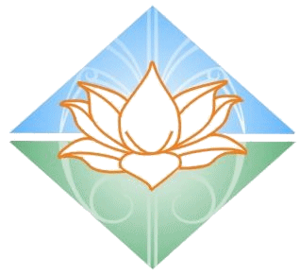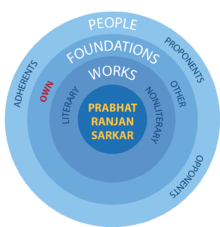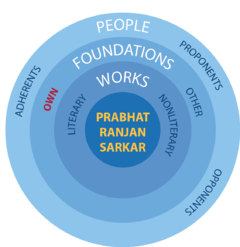Ananda Marga
| This article or section is in the process of an expansion or major restructuring. You are welcome to assist in its construction by editing it as well. If this article or section has not been edited in several days, please remove this template. This article was last edited by Abhidevananda (talk | contribs) 10 years ago. (Purge) |
| Ananda Marga | |
|---|---|
 | |
| Abbreviation | AM |
| Motto | Átmamokśárthaḿ Jagaddhitáyaca (liberation of self and service to all) |
| Founder(s) | Shrii Shrii Anandamurti |
| Type | Spiritual path |
| Headquarters | Anandanagar |
| Region served | Worldwide |
| Membership | Private persons |
| Website | www.anandamarga.org |
| Location in Sarkarverse | |
Ánanda Márga (Sanskrit: आनन्द मार्ग ānanda mārga "The Path of Bliss", also spelled Anand Marg and Ananda Marg) is the comprehensive spiritual path (set of spiritually based or spiritually oriented practices) prescribed by Prabhat Ranjan Sarkar aka Shrii Shrii Anandamurti.[note 1]
History
On 1939 August 2, (at 8:30 pm, on the full moon day of Shravani[note 2] Purnima[note 3]), Sarkar imparted tantric initiation to Kalicharan Bandyopadhyay (after aka Kalikananda Avadhuta) at the Kashi Mitra Ghát́ on the bank of the Bhagirathi river in Kalikata (aka Kolkata or Calcutta), West Bengal, India. This was the start of Sarkar's formal teaching. Sarkar was 18 years old at the time. From 1941 until 1954, Sarkar continued teaching the yogic techniques of tantra[note 4] to a select few in Jamalpur (in Bihar, India), while employed as an accountant of the Indian Railways. In 1955, Sarkar founded the Ananda Marga Pracaraka Samgha, taking on the role of its first president. Sarkar then resigned from his job with the Indian Railways to dedicate his full time to that mission. From 1955 until his death in 1990, Sarkar not only went on expanding the scope and global penetration of the Samgha, but he also continuously amplified the teachings and practices of his Ananda Marga. Among other things, in the course of those 35 years, he produced over 200 books on a wide range of topics, he extensively expounded his social theory (PROUT), he set forth his ultra-positive social outlook (Neohumanism), and he composed 5,018 songs (Prabhat Samgiita). To promote his Ananda Marga, Sarkar created a cadre of spiritual teachers, known as tattvikas and acaryas. Those teachers who became renunciates were initiated by Sarkar into the Shaivite order of avadhuta.
Unlike most other tantric or yogic missions, Ananda Marga has only one Guru, Shrii Shrii Anandamurti. After his demise, the role of Marga Gurudeva was not passed on to a successor. Hence, the fundamental philosophy and practices of Ananda Marga are largely fixed.
Conceptual framework
Just as the eight-fold path of Buddhism is inspired by what Buddhists refer to as the Four Noble Truths, Ananda Marga is also guided by a well-developed conceptual framework. This is set out in the five chapters of Sarkar's Ananda Sutram.[1]
In philosophical terms, the stance of Ananda Marga is best described as advaetadvaetádvaetaváda (non-dualistic dualistic non-dualism).[2] Originally and ultimately, everything is the singular consciousness.
In psychological terms, the stance of Ananda Marga is positive and optimistic. In a nutshell:
- The desire for sukha (happiness) is the primary drive of living beings.
- Only establishment in unlimited happiness can satisfy all thirsts.
- The unlimited is a singular, supreme entity (Brahma), beyond physical and psychic constraints.
- Consciously striving for attainment of the Supreme is dharma sádhaná (self-actualization).
According to Sarkar, when a conscious desire for liberation or perfection arises in the mind, one attains the sadguru (unfailing spiritual guide).[3]
In practical terms, the stance of Ananda Marga is rational and pragmatic. Ananda Marga rejects dogma and ritualistic worship, including religious prayer, in favor of subjective approach through objective adjustment.[4] To enhance devotion (love for the Supreme), Ananda Marga prescribes various yogic and tantric practices for physical, mental, and spiritual development, which Sarkar encapsulated in his Sixteen Points.[note 5]
In social terms, the stance of Ananda Marga is unifying. Ananda Marga sees a happy blending of individual and collective welfare. In the final analysis, the welfare of the individual depends on the welfare of the collectivity and vice versa.[5] To materialize a progressive society in which this condition is recognized and materialized, Sarkar introduced his Progressive Utilization Theory and Neohumanism.
Discipline
The practical discipline (cult) of Ananda Marga consists of sixteen elements, commonly referred to as the Sixteen Points. These sixteen points are:
References
Footnotes
- ^ Ánandamúrti, as he was called by his early disciples, is a Saḿmskrta word meaning "Bliss personified".
- ^ Shravan is the fifth month of the Indian lunar calendar, beginning in late July and ending in the third week of August. It is the month of festivals, commemorating the precedence of the sacred over all aspects of life.
- ^ Shravani Purnima is the full moon in the month of Shravan.
- ^ P.R. Sarkar clearly explained in his books the meaning of Tantra: "What is Tantra? The process of transforming (latent divinity) into the Supreme Divinity is known as Tantra sadhana... The significance of the term tantra is 'liberation from bondage (the bondage of dullness or staticity)'. The letter ta is the seed (sound) of dulness. And the root verb trae suffixed by da becomes tra, which means 'that which liberates' - so the spiritual practice which liberates the aspirant from the dullness or animality of the static force and expands the aspirant's (spiritual) self is Tantra sadhana. So there cannot be any spiritual practice without Tantra. Shrii Shrii Anandamurti (Ac. Vijayananda Avt. Editor) (1994) Discourses on Tantra 2 AMPS-Ananda Printers "Tantra in itself is neither a religion nor an 'ism'. Tantra is a fundamental spiritual science. So wherever there is any spiritual practice it should be taken for granted that it stands on the Tantric cult. Where there is no spiritual practice, where people pray to God for the fulfillment of narrow worldly desires, where people's only slogan is "Give us this and give us that" – only there do we find that Tantra is discouraged. So only those who do not understand Tantra, or even after understanding Tantra do not want to do any spiritual practice, oppose the cult of Tantra." (Anandamurti, Shrii Shrii, 1959).
- ^ Sarkar formulated his Sixteen Points in 1971 about a month before his arrest on December 29.
Citations
- ^ Shrii Shrii Anandamurti (1961) Ánanda Sútram Jamalpur: Ananda Marga Pubs ISBN 978-8172520274
- ^ Anandamurti, Shrii Shrii (Ac. Pranavananda Avt. Editor, Ac. Vijayananda Avt. transl. from Bengali) (1981-1th ed. and followings), Namami Krsnasundaram, Kolkata: Ananda Marga Pracaraka Samgha, ISBN 978-8172521110
- ^ Shrii Shrii Anandamurti (1961) Ánanda Sútram Jamalpur: Ananda Marga Pubs ISBN 978-8172520274
- ^ Shrii Shrii Anandamurti (1961) Ánanda Sútram Jamalpur: Ananda Marga Pubs ISBN 978-8172520274
- ^ Shrii Shrii Anandamurti (1961) Ánanda Sútram Jamalpur: Ananda Marga Pubs ISBN 978-8172520274
Sources
- Anderson, Sean K.; Sloan, Stephen (2009), Historical Dictionary of Terrorism, Scarecrow Press, ISBN 978-0-8108-5764-3
- Ahtrens, Wolfgang (1982), Die Weisheit der Tantralehre, Mainz: Dharma Verlag, ISBN 3-921769-04-3
- Ānanda Mitra Āc., Avt. (1981), The Spiritual Philosophy of Shrii Shrii Anandamurti: a Commentary on Ananda Sutram, DenverColorado: Ananda Marga Publications, ISBN 81–7252–154–5 Check
|isbn=value (help) - Ānanda Mitra Āc., Avt. (1986), Neo-humanist Education: Education for a New World, Ananda Marga Publications
- Anandamurti, Shrii Shrii (1955), Ánanda Márga Elementary Philosophy, Jamalpur: Ananda Marga Pubs, ISBN 81–7252–117–0 Check
|isbn=value (help) - Anandamurti, Shrii Shrii (1959), Tantra and its Effect on Society, Bhagalpur: Ananda Marga Pubs
- Anandamurti, Shrii Shrii (Ac. Vijayananda Avt. Editor) (1994), Discourses on Tantra, vol. 1, Kolkata: Ananda Marga-Ananda Printers, ISBN 81–7252–112–X Check
|isbn=value (help) - Anandamurti, Shrii Shrii (Ac. Vijayananda Avt. Editor) (1994), Discourses on Tantra, vol. 2, Kolkata: Ananda Marga-Ananda Printers, ISBN 81–7252–112–X Check
|isbn=value (help) - Anandamurti, Shrii Shrii (Ac. Narayanananda Avt. Editor, Ac. Vijayananda Avt. transl. from Bengali) (1985), Namah Shivaya Shantaya, Calcutta: Ananda Marga-Ananda Printers, ISBN 81-7252-098-0
- Anandamurti, Shrii Shrii (Ac. Sarvatmananda Avt. Editor) (2010-originally published in Bengali: 1958), Yoga Sadhana, Kolkata: Ananda Marga Publications, ISBN 978-81-7252-245-2
- Anandamurti, Shrii Shrii (1957-1981), A Guide to Human Conduct, Jamalpur: Ananda Marga Pubs, ISBN 81–7252–103–0 Check
|isbn=value (help) - Barker, Eileen (1989), New Religious Movements: A Practical Introduction, London: HMSO, ISBN 1-58391-824-8
- Bowker, John (2012), The Concise Oxford Dictionary of World Religions, Encyclopedia.com
- Bussey, Marcus (2010), "Education for Liberation. A Cornerstone of Prout", in Towsey, Michael & Karlyle, Jake, Understanding Prout – Essays on Sustainability and Transformation 1, Maleny: Proutist Universal, Australia
- Cheong Cheng, Cheong Cheng Yin; et al. (eds.) (2002), Subject Teaching and Teacher Education in the New Century: Research and Innovation, Springer, p. 194, ISBN 962-949-060-9
- Chryssides, George D. (1999), Exploring New Religions, Continuum International Publishing Group, p. 370, ISBN 0-8264-5959-5
- Coyle, Gary (1985), Progressive socialism, Calcutta: Proutist Universal Publications
- Dalal, Roshen (23 November 2011), The Religions of India: A Concise Guide to Nine Major Faiths, Penguin Books India, ISBN 978-0-14-341517-6
- Dharmavedananda, Ác. (1999), Travel with the Mystic Master, Singapore: Ananda Marga Publications, ISBN 981-04-0864-1
- Fukui, Haruhiro (1985), Political Parties of Asia and the Pacific, Greenwood Press, p. 357, ISBN 0-313-21350-X
- Hinduism Today staff (May 1, 1989), Ananda Marga: Controversial Movement Survives Years Of Conflict, Emerges Stronger Than Ever, Hinduism Today Magazine
- Galtung, Johan; Inayatullah, Sohail (1997), Macrohistory and macrohistorians: perspectives on individual, social, and civilizational change, Praeger, ISBN 978-0-275-95755-1
- Hermans, C.A.M. et al. (2001), Social Constructionism and Theology, BRILL, ISBN 90-04-12318-0
- Ishwaran, Karigoudar (1999), Ascetic Culture: Renunciation and Worldly Engagement, Brill Publishers, p. 9, ISBN 90-04-11412-2
- John, Wilson; Parashar, Swati (2005), Terrorism in Southeast Asia: Implications for South Asia, Pearson Education India, ISBN 978-81-297-0998-1
- Jones, Constance; Ryan, James D. (2007), Encyclopedia of Hinduism, Infobase Publishing, ISBN 978-0-8160-7564-5
- Lewis, James R. (2011), Violence and New Religious Movements, Oxford University Press, ISBN 978-0-19-973563-1
- MacDougall, Curtis Daniel (1983), Superstition and the Press, Prometheus Books, p. 446, ISBN 0-87975-211-4
- Maggipinto, Antonello (2000), "Multilanguage Acquisition, New Technologies, Education and Global Citizenship", in American Association for Italian Studies, Academic journal article from Italian Culture 18–2, New York: AAIS, p. 147
- Melton, J. Gordon; Baumann, Martin (2010), Religions of the World, Second Edition: A Comprehensive Encyclopedia of Beliefs and Practices, ABC-CLIO, ISBN 978-1-59884-204-3
- Miller, Timothy (1999), The 60's Communes: Hippies and Beyond, Syracuse University Press, p. 108, ISBN 0-8156-0601-X
- Ng, Franklin (1995), The Asian American Encyclopedia, Marshall Cavendish, p. 669, ISBN 1-85435-677-1
- Prins, Herschel A. (2005), Offenders, Deviants Or Patients?, Psychology Press, p. 251, ISBN 1-58391-824-8
- Sarkar, Prabhat Rainjan (Ac. Krsnatmananda Avt. Editor) (1991 third ed.), Microvitum in a nutshell, Kolkata: Ananda Marga Publications
- Sarkar, Prabhat Ranjan (1968), PROUT in a Nutshell Part 15, Ananda Marga Publications
- Sarkar, Prabhat Ranjan (1957), Yogic Treatments and Natural Remedies, Jamalpur: Ananda Marga-Ananda Printers, ISBN 81–7252–178–2 Check
|isbn=value (help) - Vijayananda, Avt. (1994), Anandamurti As I Knew Him, Kolkata: Ananda Marga-Ananda Publications, ISBN 81-7252-072-7
Online sources
- Monier Williams (2012), Monier Williams Sanskrit-English Dictionary On-line, Digital Sanskrit Dictionaries of the State University of Cologne, retrieved 23 December 2012
- A. Jones and A.D. Ryan (2007), Ananda Marga Yoga Society, Encyclpedia of Hinduism, retrieved 16 August 2013
Further reading
- Ananda Marga Aa. Vv. (1973, 2nd ed.) Teaching asanas: An Ananda Marga manual for teacher Los Altos Hills: Ananda Marga Publications ISBN 0-88476-000-6
- Acarya Prasiidananda Avadhuta (1990) Neo-Humanist Ecology Ananda Marga Publications ISBN 971-8623-12-4
- Avadhūtika Ānanda Mitra Ācāryā (1986) Neo-humanist Education: Education for a New World Ananda Marga Publications ISBN 0-88476-007-3
- Anandamurti, Shrii Shrii (1995-6th ed.) Ananada Marga Caryacarya, part 1 Ananda Marga Publications ISBN 81–7252–028–X Check
|isbn=value (help) - Anandamurti, Shrii Shrii (1987-4th ed.) Ananada Marga Caryacarya, part 2 Ananda Marga Publications
- Anandamurti, Shrii Shrii (1992-4th ed.) Ananada Marga Caryacarya, part 3 Ananda Marga Publications ISBN 81–7252–154–5 Check
|isbn=value (help) - Anandamurti, Shrii Shrii (1961) Ánanda Sútram Jamalpur: Ananda Marga Pubs ISBN 81– 7252– 027– 1 Check
|isbn=value (help) - Nandita, & Devadatta. (1971). Path of bliss: Ananda Marga yoga. Wichita, Kan: Ananda Marga Publishers.
- Hatley, Shaman and Inayatullah, Sohail. (1999),"Karma Samnyasa: Sarkar’s reconceptualization of Indian ascetism”, in K. Ishwaran, ed., Ascetic culture: renunciation and worldly engagement (Leiden, Brill,Vol. 73, International Studies in Sociology and Social Anthropology),139-152
- Inayatullah, Sohail. (2002) Understanding Sarkar: The Indian Episteme, Macrohistory and Transformative Knowledge. Leiden: Brill.
- Tarak. (1990). Ananda Marga, social and spiritual practices. Calcutta: Ananda Marga Publications.
- Anandamurti, Shrii Shrii. (1988). Ananda Marga ideology and way of life in a nutshell. Calcutta: Ānanda Mārga Pracāraka Saṁgha.
- Sarkar, Prabhat Rainjan (1957-1968) Problems of the Day Jamalpur: Ananda Marga Pubs ISBN 81-7252-019-0
- Sarkar, Prabhat Rainjan (Ac. Pranavnanda Avt. Editor) (1961-2001) Idea and Ideology Kolkata: Ananda Marga Publications ISBN 81-7252-205-3
- Sarkar, Prabhat Rainjan (1957 first ed. in Bengali, 1983 first ed. in English) Yogic Treatments and Natural Remedies Jamalpur/Calcutta: Ananda Marga Publications ISBN 81–7252–178–2 Check
|isbn=value (help) - Sarkar, Prabhat Rainjan (1982) The Liberation of Intellect: Neohumanism Kolkata: Ananda Marga Publications ISBN 81–7252–168–5 Check
|isbn=value (help) - Sarkar, Prabhat Rainjan (1987) Neohumanism in a Nutshell, vol. 1 Kolkata: Ananda Marga Publications ISBN 81-7252-184-7
- Sarkar, Prabhat Rainjan (1987) Neohumanism in a Nutshell, vol. 2 Kolkata: Ananda Marga Publications ISBN 81-7252-184-7

